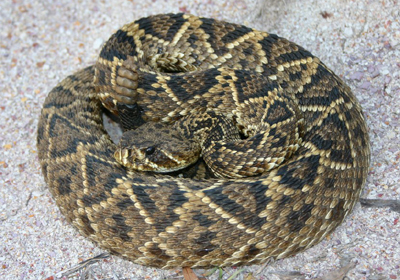
CULLMAN, Ala. – The fear of snakes, or ophidiophobia, is one of the most common phobias among humans. There is a debate in the scientific community as to whether or not the fear is learned or part of human evolution as a survival mechanism. Regardless of the fear, it is important for people to know how to identify venomous and nonvenomous snakes and be aware of the benefits snakes have to the ecosystem.
The Tribune sat down with Tony Glover, Cullman County Extension coordinator, to learn more about snakes that are native to Cullman.
He said, “There are four or five deaths nationwide in a year, if that much. It’s probably less. It’s extremely rare. They are more likely to get killed trying to kill the snake in an accident related than if they just avoided it. People just get so distraught over seeing a snake. Even if they get bit by a venomous snake, it’s extremely rare that someone would die from that. There are a lot more people allergic to bees and wasps and die each year from stings.”
There are several things a homeowner can do to significantly decrease the likelihood of snakes being on his or her property.
Glover gave the following advice, “Make sure there’s no piles of debris or rock piles, areas where snakes would tend to go for cover because they are being preyed upon by owls and hawks. I saw a hawk swoop down one day on my way home on the road I live on and catch a snake. So, they are looking for places to hide and places that aren’t disturbed very often. A snake feels safe in places with very little human activity. Anything they can do to alter the habitat to have less desirable places for them to shelter and hide.”
A well-maintained and mowed yard means fewer hiding spots and will help you spot a snake. Some experts also say that having a dog present in the yard can deter snakes. There is always a chance that a snake will pass through despite these suggestions.
Benefits of snakes
There are benefits to snakes being around. Snakes can keep rodent populations under control and nonvenomous snakes often prey upon the venomous ones
Added Glover, “Trying to get rid of all snakes just because you see one is counterproductive for your goals and trying to have a balance. It’s OK for them to have habitat at the edge of the yard or the areas you aren’t frequenting. It’s a beneficial thing.”
King snakes, which are common in Cullman County, are resistant to the venom of pit vipers and prey upon the rattlesnakes, copperheads and cottonmouths that most people fear most. They also eat rodents.
“I would advise homeowners, if they have kids that are going to be playing in the yard, take a trip through the yard with a stick and check the areas you can’t openly see around shrubbery, rocks and things like that. Just try to disturb them that they might say, ‘Hey let’s get on out of here’ because they aren’t looking for an encounter. Usually if people get bit it’s because they didn’t see them and stepped on them or near them.”
Snake identification
An estimated 40-50 species of snakes can be found in Alabama. Of those 40 species, only six are venomous. Of the six venomous snakes, five are native to Cullman County: Eastern Diamondback Rattlesnakes, Timber Rattlesnakes, Pygmy Rattlesnakes, Copperheads and Cottonmouths/Water Moccasins. The sixth is the Coral Snake, but they are rarely found as far north as Cullman County.
The most common snakes are nonvenomous, with the rat snake being the most common. The five venomous snakes indigenous to Cullman County are pit vipers and they all give birth to live young.
In an article for the Alabama Cooperative Extension Service, Jim Armstrong wrote, “Pit vipers get their name from the presence of pits on both sides of the face between the eye and nostril. These pits are used to detect heat and improve the snakes’ accuracy in striking warm-blooded prey. Pit vipers have vertical or ‘cat-like’ pupils, thin necks, and heavy bodies. While all pit vipers have wide, triangular heads, some nonvenomous snakes share this characteristic. Pit vipers are also characterized by having retractable, hollow fangs near the front of the mouth. The nonvenomous snakes in Alabama also have round pupils and small heads. Another distinguishing characteristic of all nonvenomous snakes is the double row of scales on the underside of the tail. All of the pit vipers have a single row of scales. However, like nonvenomous snakes, the coral snake has a double row.”
There are colorful snakes that live in our area such as the Scarlett King Snake that appear very similar to the coral snake. Just remember: “Red on yellow, kill a fellow. Red on Black, a friend of Jack.”
Younger snakes are more likely to strike and inject venom than the adult snakes, but most snakes are going to try and get away from humans. They strike when they feel threatened.
What do you do if you’re bitten by a snake you suspect is venomous?
According to Spencer Green, M.D., a medical toxicologist and emergency physician at Baylor College of Medicine in Houston, Texas, you should take the following steps:
- Get away from the snake. No need to hurt the snake just because you’re angry, and you don’t want to incur additional injury.
- If you (or someone else) can safely and quickly get a picture of the snake, great, but don’t waste time or risk a second envenomation. Ultimately, pit viper (rattlesnakes, copperheads, cottonmouths/water moccasins) envenomations are diagnosed clinically. As are coral snake bites, but most people can identify those.
- Remove constrictive clothing and jewelry
- Position the affected extremity appropriately. DO NOT PLACE BELOW HEART LEVEL. Almost all pit viper bites cause local tissue injury, and placing the affected extremity below heart level will cause the venom to collect in the extremity and will increase the hydrostatic pressures in the extremity. This will increase the potential damage to lymphatic vessels and increase the likelihood of some degree of permanent injury, such as post-exertional swelling. For copperhead and cottonmouth bites, in which local tissue is highly likely but the likelihood of systemic toxicity is low, I recommend placing the affected extremity ABOVE HEART LEVEL. In rattlesnake bites, it is reasonable to keep the affected extremity AT HEART LEVEL. These variations are for pre-hospital management. Once in the hospital, the affected extremity should always be elevated. This is emphasized in the unified treatment algorithm.
- Get to an appropriate hospital. If you are having life-threatening signs and symptoms (e.g. airway issues, low blood pressure) get to the closest hospital for stabilization. They can then transfer you if needed to an expert. Otherwise, proceed directly to a hospital with a snakebite expert.
Green also emphasizes actions that should not be taken, saying:
- DO NOT apply a tourniquet.
- DO NOT apply any sort of constriction band or pressure immobilization for pit vipers.
- DO NOT use electrical shock treatment.
- DO NOT apply heat.
- DO NOT apply PROLONGED icepacks. A few minutes at a time is okay (say, 5 minutes on, 10 minutes off) but prolonged cryotherapy is bad for the tissue.
- DO NOT use one of those commercially-available suctions devices.
- Do NOT bring the snake to the hospital.
Snakes live in Cullman County, and although many might fear them, there are some logical things a person can do to limit the likelihood of having a close encounter. Experts say that despite the fear, people should be rational and remember that snakes are a vital part of the ecosystem.
Said Glover, in Cullman County, the odds of being killed by a cow are far greater than being hurt by a snake.
Copyright 2019 Humble Roots, LLC. All Rights Reserved.
Venomous Snakes of Alabama by TheCullmanTribune on Scribd




















